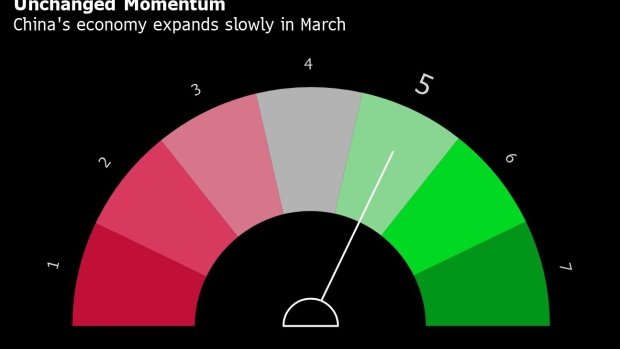Mar 24, 2022
China Struggles to Keep Growth Momentum Strong as Risks Escalate
, Bloomberg News

(Bloomberg) -- China struggled to boost economic momentum in March, as slumping car and home sales, stock market turmoil and higher inflation weighed on growth and a fresh round of Covid outbreaks swept across the country.
That’s the outlook from Bloomberg’s aggregate index of eight early indicators for this month. The overall indicator for the economy was unchanged from last month, but sub-indexes weakened almost across the board.
China is battling its worst wave of outbreaks since the initial flareup two years ago and the nation’s stringent Covid Zero approach has proven increasingly costly. Factories in manufacturing hubs including Shenzhen were forced to temporarily halt production, and consumers were told to stay home as authorities try to contain the highly contagious omicron variant.
Places designated middle and high-risk virus areas now exceed 30% of China’s gross domestic product, according to Goldman Sachs Group Inc. estimates. If a four-week lockdown was imposed in these areas, annual GDP would be reduced by 1 percentage point, the bank’s economists said. That would make it even harder for Beijing to achieve its ambitious growth target of around 5.5% set for the year.
Business sentiment among smaller firms improved further this month, largely due to a seasonal rebound from the week-long Lunar New Year holidays in February, according to Standard Chartered Plc’s survey of more than 500 smaller firms. However, the improvement paled in comparison to the historical average, the bank’s economists Hunter Chan and Ding Shuang wrote in a report. And a drop in the average reading of the performance sub-index in the first quarter suggests economic activity slowed from the fourth quarter, they said.
Global demand remained resilient, although the pace of expansion continued to weaken from the previous month. South Korea’s exports, a leading indicator of global trade, advanced 10.1% in the first 20 days of March from a year earlier. The double-digit gain was the slowest since December 2020, likely due to geopolitical and virus risks weighing on global demand.
The Standard Chartered survey also pointed to a normalization of external demand, with new export orders contracting and performance of export-oriented small and mid-sized firms softening in the first quarter.
The property market continued to weaken, with home sales slumping in March despite the fact that more Chinese cities have recently eased restrictions in order stimulate demand, such as by cutting mortgage rates and down payments on loans. Car sales also dropped, indicating that consumer sentiment was weak amid the repeated outbreaks.
The stock market fell in March, as heightened geopolitical tensions linked to Russia’s military attack on Ukraine sent global markets plunging. The benchmark index is down about 14% this year. China’s top financial policy body last week made a strong vow to ensure stability in capital markets, providing some respite to investors.
Early Indicators
Bloomberg Economics generates the overall activity reading by aggregating a three-month weighted average of the monthly changes of eight indicators, which are based on business surveys or market prices.
- Major onshore stocks - CSI 300 index of A-share stocks listed in Shanghai or Shenzhen (through market close on 25th of the month).
- Total floor area of home sales in China’s four Tier-1 cities (Beijing, Shanghai, Guangzhou and Shenzhen).
- Inventory of steel rebar, used for reinforcing in construction (in 10,000 metric tones). Falling inventory is a sign of rising demand.
- Copper prices - Spot price for refined copper in Shanghai market (yuan/metric tonne).
- South Korean exports - South Korean exports in the first 20 days of each month (year-on-year change).
- Factory inflation tracker - Bloomberg Economics created tracker for Chinese producer prices (year-on-year change).
- Small and medium-sized business confidence - Survey of companies conducted by Standard Chartered.
- Passenger car sales - Monthly result calculated from the weekly average sales data released by the China Passenger Car Association.
©2022 Bloomberg L.P.






